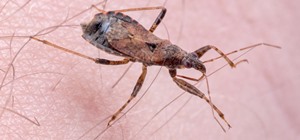Like humans, cats can suffer infections caused by ticks, and too often, the disease is fatal. Learn about tickborne diseases that affect cats and what you can do to protect Fluffy from an untimely demise.
Across the US, tickborne diseases are on the rise. With warmer wintertime temperatures, ticks are more active throughout the year and pushing into new terrain. Ticks are parasites that are not particular about their food — the blood of a cat tastes as good as that of a dog, or a human. Like dogs, some cats are frequently outside, sharing space with ticks waiting for a warm meal.
Like dogs and humans, wherever there are ticks, there is a possibility your cat could become the victim of a tickborne disease. But infections that impact people do not always sicken cats in the same way. For example, Lyme disease is a dangerous infection in humans and dogs, but is not commonly found in cats. A spiral-shaped bacterium called Borrelia burgdorferi causes Lyme disease.
In dogs, as in cats, symptoms of Lyme disease include lost appetite, fever, swelling of the joints, and apparent muscle pain. If any companion animal suffers these symptoms — head to your vet pronto.
What Infections Do Ticks Cause in Cats?
Many times, a tick bite is just that — an opportunity for a parasite to suck the blood of your cat without giving them a disease. But sometimes cats get sick. Here is a rundown of the types of infections your cat might suffer from a tick bite.
1: Cytauxzoonosis felis
First reported in 1976 in Missouri, this infection, also known as "bobcat fever," was once thought to be rare, but is becoming more widespread. Cytauxzoonosis is a protozoan that uses the North American bobcat as its host reservoir. Bobcats aren't symptomatic but are carriers of the infection for life. A 2015 study found the Cytauxzoonosis was common in domestic cats in Arkansas, Oklahoma, and Missouri. About 6.2% of cats in that region showed lab results of having been infected at one point.
Researchers suspect there are less virulent strains since the blood work shows many cats survived. These cats that survive could be lifetime vectors, like bobcats.
In its severe form, Cytauxzoonosis is a fast-moving, dangerous infection for cats. Even with recognition of symptoms, and fast treatment, the fatality rate can be high.
Two ticks are known to carry the parasite, the American dog tick, and the lone star tick. The range of these two ticks overlaps, with the American dog tick casting the wider shadow. The bobcat ranges throughout much of the US, so the infection should be considered widespread. The lone star tick is known to be an aggressive and voracious feeder.
Symptoms appear within two to three weeks of infection and include loss of appetite, dehydration, anemia, and fatigue, among other symptoms. Treat involves supportive therapy and sometimes a combination of anti-parasitic drugs.
Living indoors is considered the best preventative for this usually fatal disease. Topical application of Frontline could help ward off ticks in cats that cannot be indoors.

2: Tularemia
Both dogs and cats can contract tularemia, but for dogs, the symptoms, if any, are not severe. For cats, the bacterial infection is potentially fatal.
Your cat can get tularemia by eating an infected rodent, drinking contaminated water, or through the bite of a tick. The primary hosts are rabbits and rodents. The American dog tick spreads tularemia and symptoms may include high fever, swollen lymph nodes, pain, jaundiced eyes, and organ failure. Cats often die of the disease unless caught early. If you have a cat with suspected tularemia, be careful and cautious with your cat, humans can be infected if bitten.
3: Hemobartonellosis
Feline infectious anemia, or hemobartonellosis, is caused by a bacterial infection spread through the bite of infected mosquitoes, ticks, fleas, and lice. The disease can also be spread cat to cat through fighting, or from mother to unborn kitten.
Symptoms of fatigue, loss of appetite, fevers, and anemia appear within a week to a month of infection, and the parasites are active in the blood for three to eight weeks. Symptoms may cycle through the cat during this time. Identifying the infection is not easy, and testing sometimes misses the parasites in blood samples. Treatment with antibiotics can cure the infection, but the parasites remain, and the cats become carriers.
Other tick infections include two that afflict humans, ehrlichiosis, and babesiosis. The symptoms of these are similar to Cytauxzoonosis.
Tips to Prevent Your Cat from Getting at Tickborne Disease
Top among the ways to keep your feline friend from contracting a tickborne infection is keeping them inside the house. While you may convince yourself that Fluffy truly deserves to enjoy the great out-of-doors, consider all the things that you cat can avoid by staying inside:
- Disease: Any outdoor animal is more prone to infection and illness while roaming the 'hood. Bacteria, fungus, virus, or parasite, odds of disease, like feline immunodeficiency virus (FIV), go up outside. Ticks like to bite cats as much as they like dogs. Your cat could become infected — and they could bring ticks into your home.
- Hazards: A cat struck by a car is not a joy to behold. Sometimes far from home, these animals suffer and die when caught by a dog, are injured in a fight with another cat or animal, are caught under the wheel of a car, and in some areas, munched by neighborhood coyotes. If Fluffy never comes home, it is probably not because they found a better crashpad, he or she is likely dead.
- Numbers don't lie: Indoor cats usually live longer than their free-roaming cousins. Feral cats do not enjoy long lives and can spread diseases to your domestic cat.
- Save the birds: Roaming outdoor cats have a bigger impact than you think on songbird populations in your neighborhood. If you like to see and hear birds — keep your cat inside.
There is no vaccine for Lyme disease in cats, but there are products that deter fleas and ticks on contact. Talk to your vet about the effectiveness and dangers of collars, powders, and shampoos. As with dogs, carefully check your cat when they return home, especially around the face, ears, belly, groin, backend, and between the toes. Consider buying a flea and tick comb and give your cat some attention when they come in your house. You can bond and look for bugs at the same time.
Best advice to give Fluffy the best chance to live out those nine lives? Keep him indoors.
Just updated your iPhone? You'll find new emoji, enhanced security, podcast transcripts, Apple Cash virtual numbers, and other useful features. There are even new additions hidden within Safari. Find out what's new and changed on your iPhone with the iOS 17.4 update.



























Be the First to Comment
Share Your Thoughts